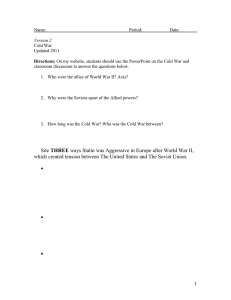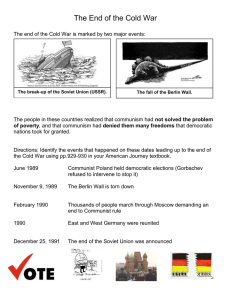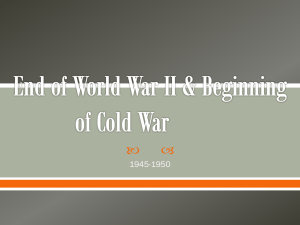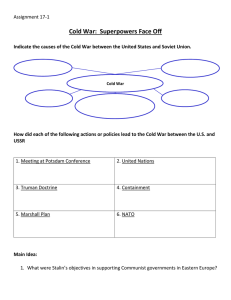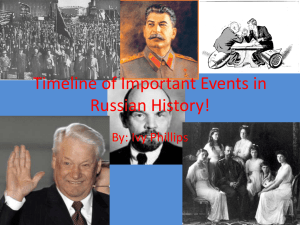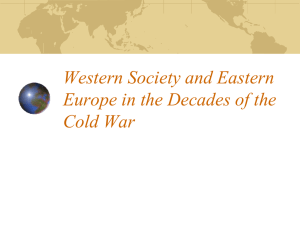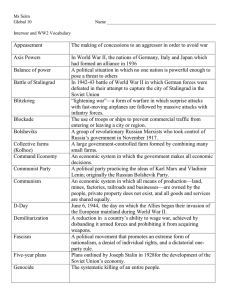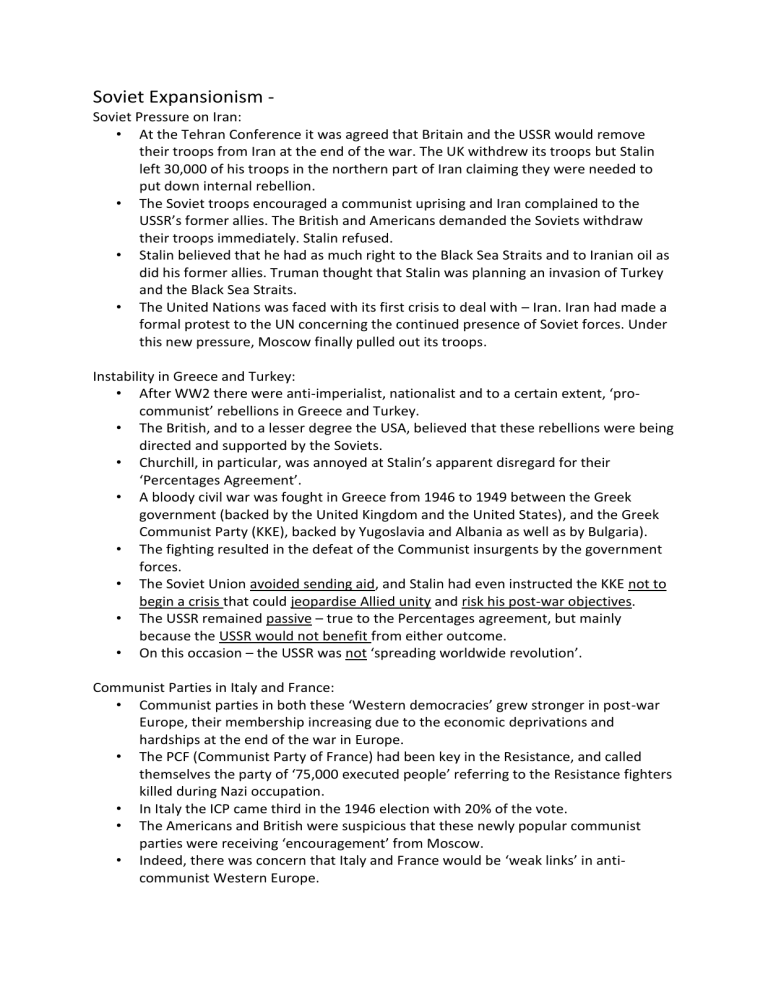
Soviet Expansionism Soviet Pressure on Iran: • At the Tehran Conference it was agreed that Britain and the USSR would remove their troops from Iran at the end of the war. The UK withdrew its troops but Stalin left 30,000 of his troops in the northern part of Iran claiming they were needed to put down internal rebellion. • The Soviet troops encouraged a communist uprising and Iran complained to the USSR’s former allies. The British and Americans demanded the Soviets withdraw their troops immediately. Stalin refused. • Stalin believed that he had as much right to the Black Sea Straits and to Iranian oil as did his former allies. Truman thought that Stalin was planning an invasion of Turkey and the Black Sea Straits. • The United Nations was faced with its first crisis to deal with – Iran. Iran had made a formal protest to the UN concerning the continued presence of Soviet forces. Under this new pressure, Moscow finally pulled out its troops. Instability in Greece and Turkey: • After WW2 there were anti-imperialist, nationalist and to a certain extent, ‘procommunist’ rebellions in Greece and Turkey. • The British, and to a lesser degree the USA, believed that these rebellions were being directed and supported by the Soviets. • Churchill, in particular, was annoyed at Stalin’s apparent disregard for their ‘Percentages Agreement’. • A bloody civil war was fought in Greece from 1946 to 1949 between the Greek government (backed by the United Kingdom and the United States), and the Greek Communist Party (KKE), backed by Yugoslavia and Albania as well as by Bulgaria). • The fighting resulted in the defeat of the Communist insurgents by the government forces. • The Soviet Union avoided sending aid, and Stalin had even instructed the KKE not to begin a crisis that could jeopardise Allied unity and risk his post-war objectives. • The USSR remained passive – true to the Percentages agreement, but mainly because the USSR would not benefit from either outcome. • On this occasion – the USSR was not ‘spreading worldwide revolution’. Communist Parties in Italy and France: • Communist parties in both these ‘Western democracies’ grew stronger in post-war Europe, their membership increasing due to the economic deprivations and hardships at the end of the war in Europe. • The PCF (Communist Party of France) had been key in the Resistance, and called themselves the party of ‘75,000 executed people’ referring to the Resistance fighters killed during Nazi occupation. • In Italy the ICP came third in the 1946 election with 20% of the vote. • The Americans and British were suspicious that these newly popular communist parties were receiving ‘encouragement’ from Moscow. • Indeed, there was concern that Italy and France would be ‘weak links’ in anticommunist Western Europe. West’s reaction to Soviet Expansionism Iron Curtain: Iron Curtain, the political, military, and ideological barrier erected by the Soviet Union after World War II to seal off itself and its dependent eastern and central European allies from open contact with the West and other noncommunist areas. Iron Curtain speech, speech delivered by former British prime minister Winston Churchill in Fulton, Missouri, on March 5, 1946, in which he stressed the necessity for the United States and Britain to act as the guardians of peace and stability against the menace of Soviet communism, which had lowered an “iron curtain” across Europe. The term “iron curtain” had been employed as a metaphor since the 19th century, but Churchill used it to refer specifically to the political, military, and ideological barrier created by the U.S.S.R. following World War II to prevent open contact between itself and its dependent eastern and central European allies on the one hand and the West and other noncommunist regions on the other. Long Telegram: In February 1946, George F. Kennan's “Long Telegram” from Moscow helped articulate the U.S. government's increasingly hard line against the Soviets and became the basis for the U.S. “containment” strategy toward the Soviet Union for the duration of the Cold War. As such his opinions on the Soviet Union were listened to in Washington. In his famous Long Telegram, Kennan warned that Stalin wanted to destroy capitalism and reported on Stalin's paranoia that the west were going to destroy him and the Soviet Union. American Anti-communist policies Truman Doctrine: President Truman declared, "It must be the policy of the United States to support free peoples who are resisting attempted subjugation by armed minorities or by outside pressures." The sanction of aid to Greece and Turkey by a Republican Congress indicated the beginning of a long and enduring bipartisan Cold War. With the Truman Doctrine, President Harry S. Truman established that the United States would provide political, military and economic assistance to all democratic nations under threat from external or internal authoritarian forces. Marshall Plan: - The Marshall Plan was designed to give immediate economic help to Europe. - The stated aims of the Marshall Plan aid were to: o Review European working conditions so that political and social stability could ensue o Safeguard the future of the US economy - However, to avoid the interpretation that the United states was in any way coercing European governments to accept the aid plan, it was made clear that ‘the initiative must come from Europe’. - The bill allocating the four year programme of $17billion did not pass the US Congress until March 1948. Dollar Imperialism: The USSR objected to the Marshall plan in the following ways: It declared Marshall Aid to be 'dollar imperialism' and claimed the USA was throwing its economic weight around, using it to gain influence in Europe. It forbade the Eastern Bloc countries under its control to apply for Marshall Aid. The Soviet Response Comecon: • In response to the Marshall Plan, the Soviets came up with the Molotov Plan, which was a series of bilateral trade agreements aimed to tie the economies of Eastern Europe to the USSR. • The outcome was the creation of COMECON in January 1949. COMECON was the Council for Mutual Economic Assistance. • This was a centralised agency that linked Eastern bloc countries to Moscow. It was designed to ‘stimulate’ and control their economic development and support the collectivisation of agriculture and the development of heavy industry. Cominform: • This was the Communist Information Bureau set up in September 1947. It was created as an instrument to increase Stalin’s control over the Communist parties of other countries. • It was initially comprised of Communists from the USSR, Yugoslavia, France, Italy, Poland, Bulgaria, Hungary and Romania. • The West was concerned that this organisation would actively spread communism (and destabilise the democratic governments) in the West’s own ‘sphere of influence’ – Western Europe. Two Camps Doctrine: • Stalin developed his ideal of a Europe divided into 2 opposing camps in the 1920s and 1930s. • Following WW2 this idea, in the divisive context of post-war international relations, became a firm foundation for Soviet foreign policy. Spread of Communism Red Army occupation of Eastern Europe: At the end of World War II, the Soviet Union occupied Bulgaria, Romania, Hungary, Poland and eastern Germany. Great Britain, the United States, France, and the Soviet Union divided Germany and Berlin into four occupation zones to be administered by the four countries. Communist coup in Czechoslovakian: • • • • • Communists mounted a coup d’état Police force taken over by communists Non-communist personnel removed from government Fear & coercion used to remove remaining opponents, e.g. Jan Masaryk defenestrated President Benes forced to resign & replaced by communist Gottwald. Hungarian dictatorship: • Hungary was invaded by the Russians, and in 1945 the allies agreed that Russian troops should stay there. • • • • Stalin allowed elections, in which the non-communists won a big majority. However, some communists were elected, led by a pro-Russian called Rakosi. Rakosi now started demanding that groups which opposed him should be banned. If not, he hinted, the Russians would take over the country. T hen he got control of the police, and started to arrest his opponents. He set up a sinister and brutal secret police unit, the AVO. By 1947 Rakosi had complete control over Hungary Soviet atomic bomb: • • • • On August 29, 1949, the Soviet Union exploded its first atomic bomb. It came as a great shock to the United States because they were not expecting the Soviet Union to possess nuclear weapon knowledge so soon. Previously, the United States had used two atomic bombs on Japan to cause them to surrender during World War II. The impact that the possession of nuclear weapons by the Soviet Union had upon the United States was that it caused Americans to question their own safety. President Truman responded by re-evaluating the United States position in the world and called for the United States to build up its conventional and nuclear weapons to halt the spread of Soviet influence around the globe. China becomes communist: • • • • • During the Chinese Civil War (1945-9) the USA had given limited support to the Nationalists under Chiang Kai-shek. When the country ultimately fell to the communist guerrilla (not gorilla!) forces of Mao Zedong, the White Paper report on this clearly stated that the USA could not substantially have altered the outcome. It suggested that Chiang and his forces were simply too unpopular with the Chinese people, and that it had been more a case of nationalist ‘collapse’ than communist ‘victory’. The White Paper saw Mao as somewhat ‘independent’ from Moscow. Secretary of State Dean Acheson expressed the US government’s view in 1949 and American experts believed that they had done what they could in China. Korean war: - First real ‘hot’ conflict of Cold War – proxy war Extended the conflict outside of Europe = broadened the ‘theatre’ of the war Strengthened American determination to stamp out communism – fear of worldwide communist takeover Led to a fresh spate of re-armament (arms race) USA tripled defence spending in the 1950s (10% of GNP) = increased militarization Red Army was increased from 2.8m in 1950 – 5.8 in 1955 Represented the globalization of the Cold War - intensified suspicion and tensions Berlin Blockade - • • • • • • Early 1948, the three Western powers decided to amalgamate their zones and introduce a new currency, the Deutschmark. Stalin was unhappy with Allied plans to rebuild Germany. In June, he tried to close off West Berlin by cutting all road, water and rail links to demonstrate he was key to decisions about rebuilding and unifying Germany. Berlin was therefore accessible only by air - British and Americans responded with a huge airlift of supplies and resources to West Berlin. At its height one plane reached West Berlin every 30 seconds. The Airlift officially ended on 30 September 1949, fifteen months after its protracted beginnings in June 1948. In total, the United States and Britain delivered 1,783,573 and 541,937 tons of supplies respectively, involving 277,569 flights to Berlin. It had been agreed at Yalta and Potsdam that Germany should be divided into four zones, each controlled by one of the Allies. Berlin was deep inside the Soviet area but the other leaders could not accept such an important city being under Soviet control, so Berlin was divided into four. It was also agreed that Germany should pay reparations to the USSR. Initially, the Allies worked together, each running their sector but uniting to make important decisions as the Allied Control Council (ACC). Increasingly, Stalin tightened his grip on East Germany and it became almost impossible for non-communists to gain any influence in how the territory was run. Political opponents were forced into exile. Yet West Berlin remained an island of Western influence within the Soviet zone. Unity in the West The West wanted Germany to be rebuilt but Stalin wanted it to remain weak and to pay reparations for the damage done during the war. It was proposed that a new currency should be introduced across the whole country but the Soviets rejected the idea. In March 1948, at a conference in London, the Western Allies decided to unite their sectors of Germany – Trizonia – and they would also introduce a new currency – the Deutschmark – to West Germany because they were concerned about the deteriorating economic situation which may have renewed political extremism amongst the Germans. Stalin was unhappy with the decision and a separate currency was planned for the East. Not only did the blockade turn out to be totally ineffective, it ended up backfiring on the Soviets in other ways. It provoked genuine fears of war in the West. And instead of preventing the establishment of an independent West Germany, it accelerated the Allies plans to set up the state. Past Paper Questions To what extent did mutual fear and suspicion contribute to the development of the Cold War between 1945 and 1949? With reference to the period from 1953 to 1991, evaluate the impact of Germany on the Cold War. Examine the reasons for changes in Sino-Soviet relations between 1956 and 1976. To what extent did arms limitation treaties between the United States and the Soviet Union improve relations during the period from 1969 to 1991? Examine the economic and cultural impact of the Cold War on one state. “Reagan and Gorbachev made an equal contribution to the end of the Cold War.” Discuss. The struggle to establish spheres of influence destroyed the wartime alliance.” Discuss with reference to US-Soviet relations up to 1950. Evaluate the successes and failures of the US policies of containment and brinkmanship up to 1962. Examine the reasons for the policy of detente, and its impact on superpower relations, between 1969 and 1979. Examine the impact of either Afghanistan or Vietnam on the Cold War. Evaluate the economic impact of the Cold War on two states, each from a different region. 30. Evaluate the role of Gorbachev in ending the Cold War. Exam the impact of the US policy of containment on superpower relations between 1947 and 1964 Evaluate the impact on the course of the cold war of two crises, each chosen from a different region To what extent did economic interests rather than ideology lead to the breakdown of the grand alliance between 1943 and 1949? Evaluate the impact of Cold War tensions on two countries (excluding the USSR and the US). ”Confrontation rather than reconciliation ended the cold war.” Discuss with reference to the period from 1980 to 1991 Evaluate the impact of two leaders, each from a different region, on the course of the cold war “Economic problems between 1980 and 1991 were the most significant reason for the end of the cold war”. To what extent do you agree with this statement Compare and contrast the impact of two leaders, each from a different region, on the development of the Cold War “Superpower rivalry in Europe and Asia between 1943 and 1949 led to the breakdown of the grand alliance” to what extent do you agree with this statement? Discuss the impact of two Cold War crises, each from a different region, on the development of Superpower tensions To what extent did the policy of peaceful co-existence improve superpower relations up to and including 1964? “The impact of Cold war tensions was mainly economic” Discuss with reference to two countries (excluding the USSR and the US) ‘China’s relations with the USSR and the US were largely shaped by increasing mistrust and suspicion” discuss with reference to the period between 1947 and 1979n Evaluate the impact of detente upon US-USSR relations up to the end on 1979 “Ideology was the most important cause of Cold War crises” Discuss with reference to two Cold war crises, each from a different region To what extent was the arms race the most important reason for the end of the Cold war (19801991) Examine the economic impact of the cold war on two countries, each chosen from a different region Evaluate the factors which led to detente between the US and USSR between 1971 and 1979 Discuss the impact of two Cold War crises on superpower rivalry “The arms race made the greatest contribution to the cold war” Discuss with reference to the period between 1980 and 1991 Examine the influence of two leaders, each chosen from a different region, on the development of the cold war
